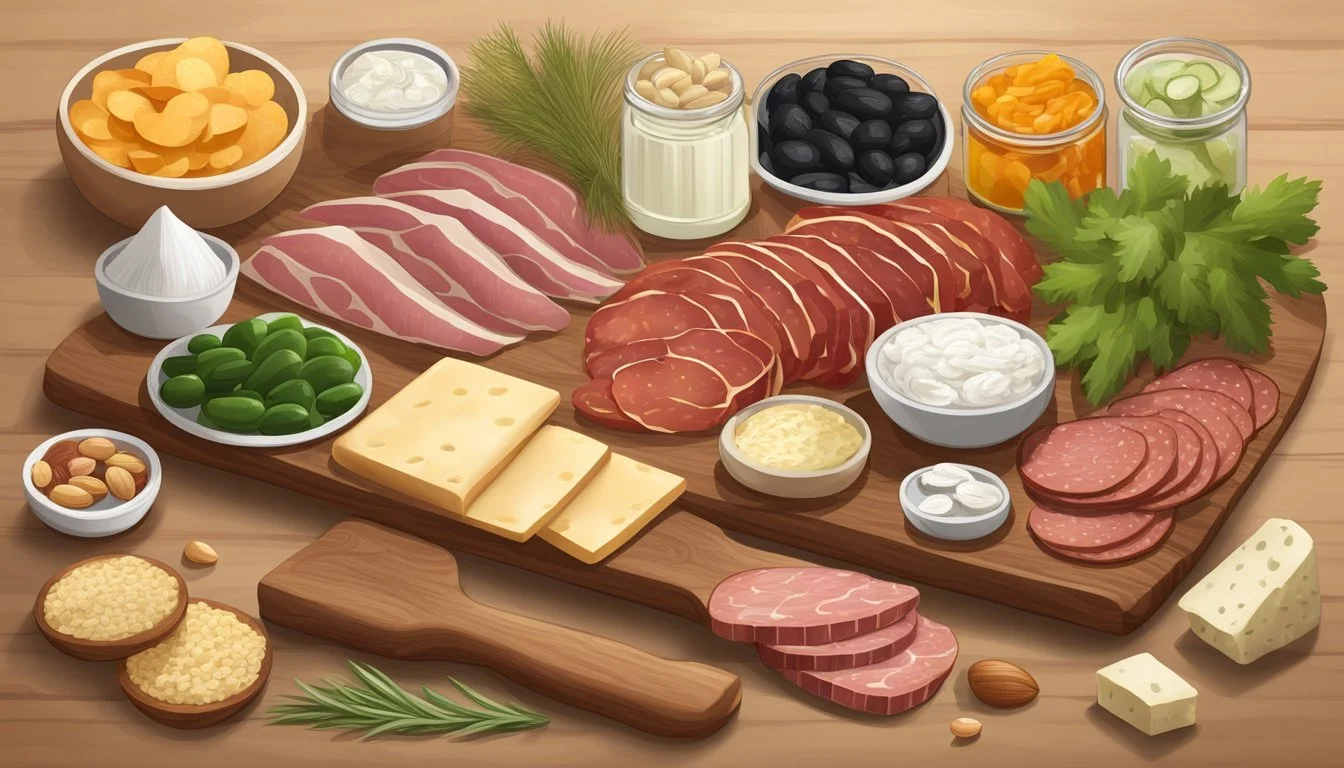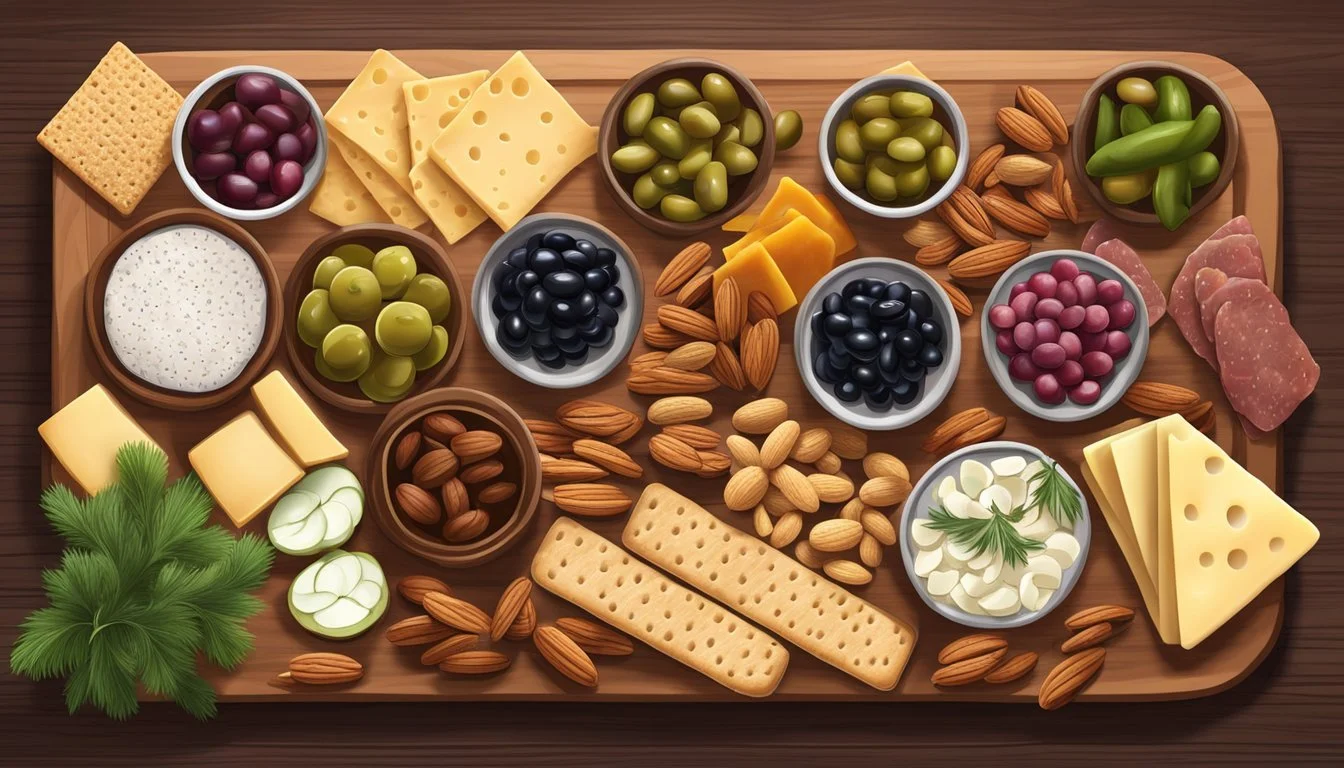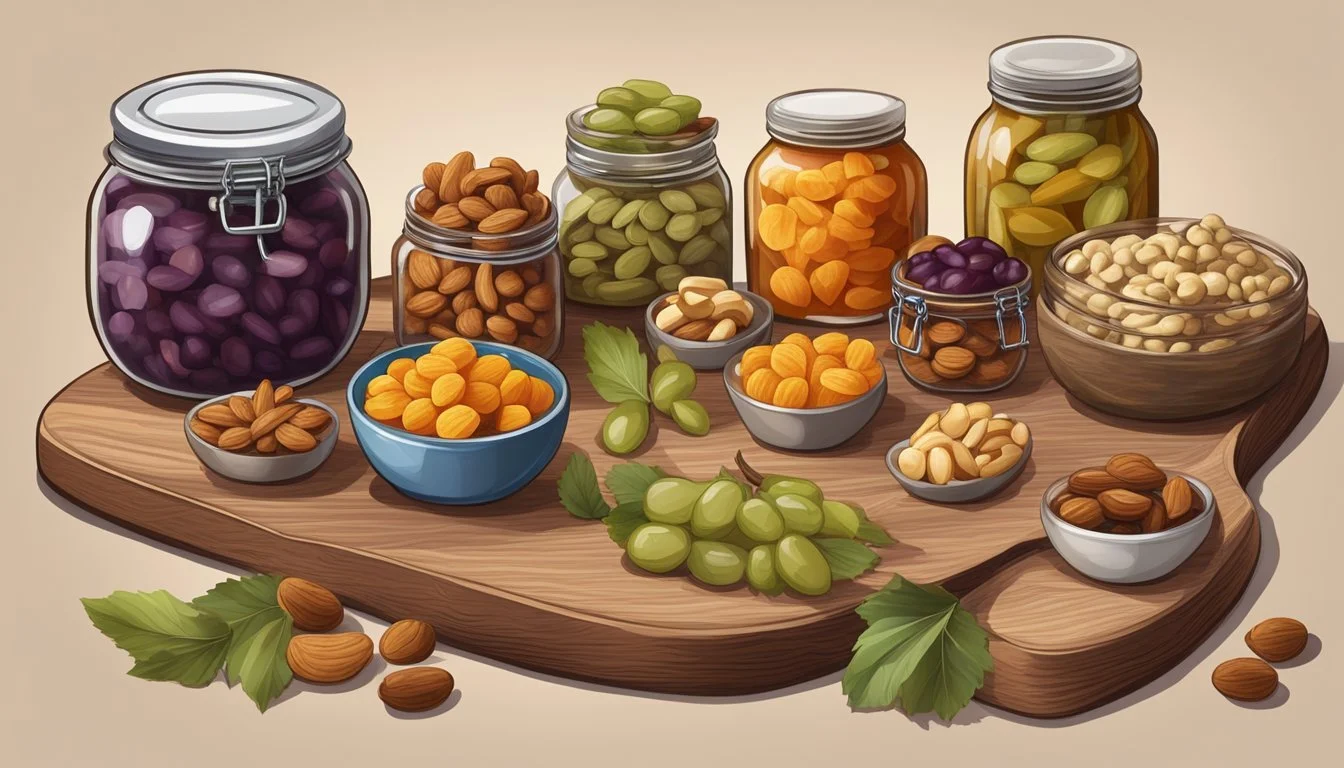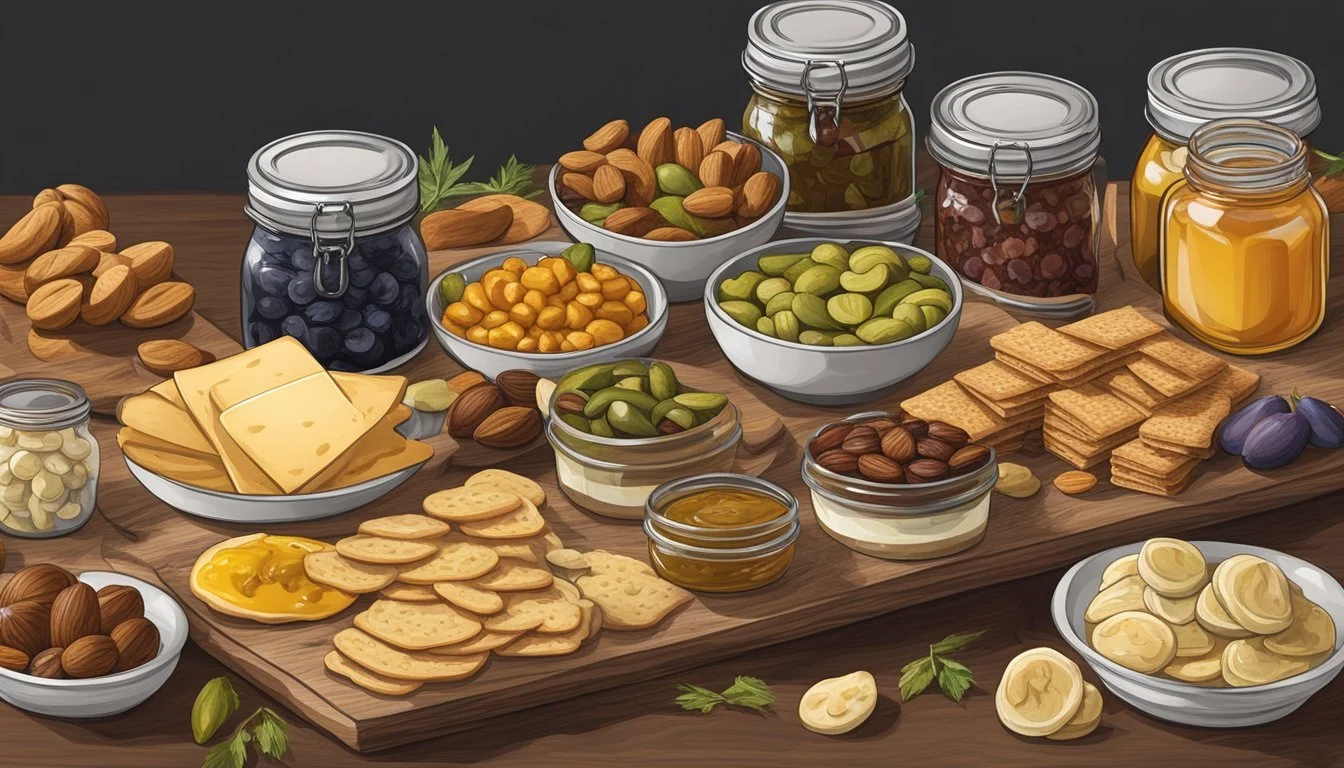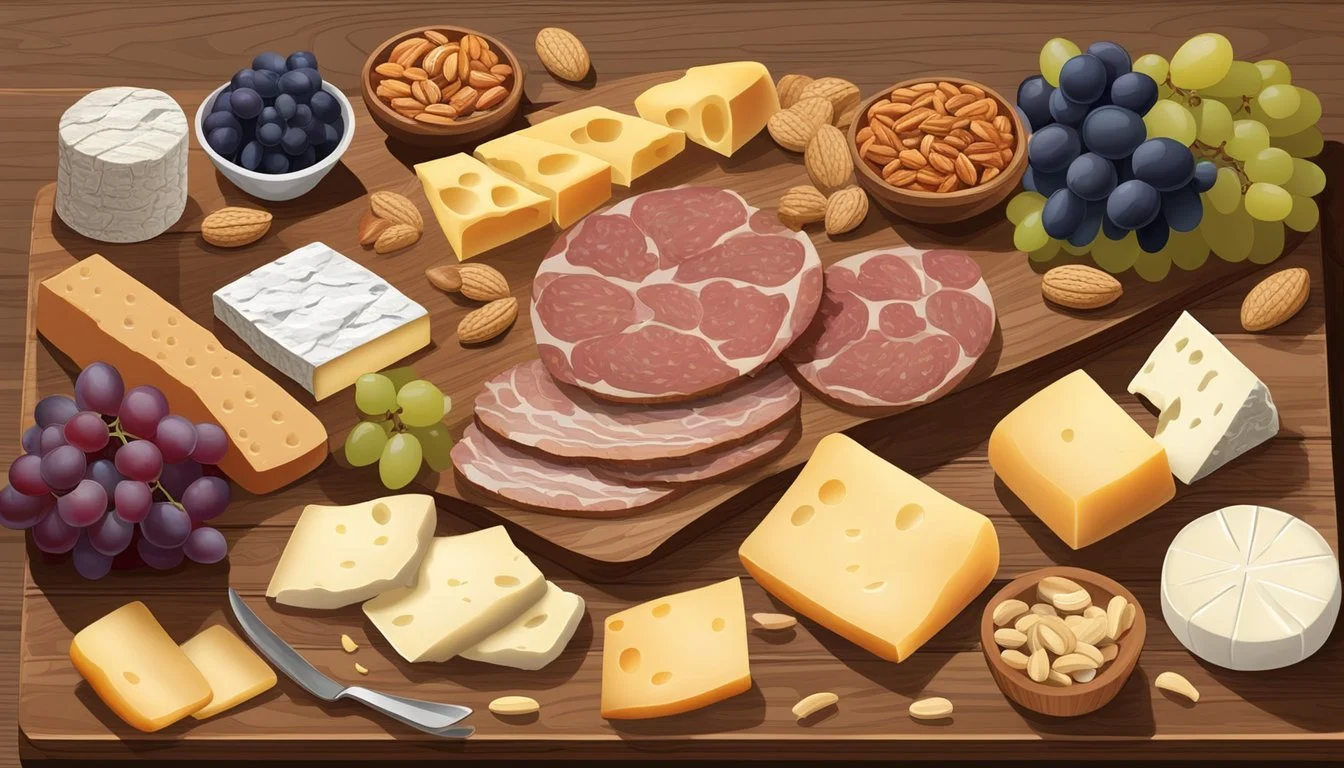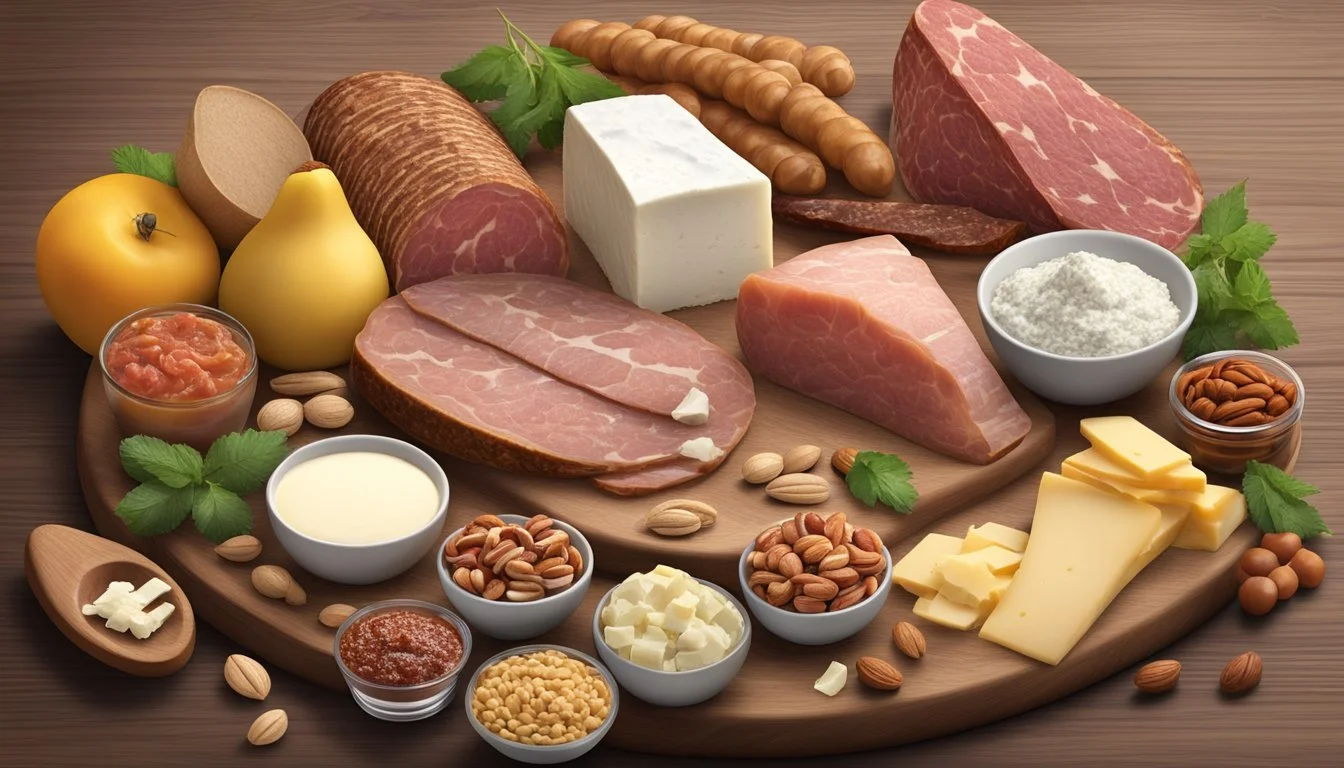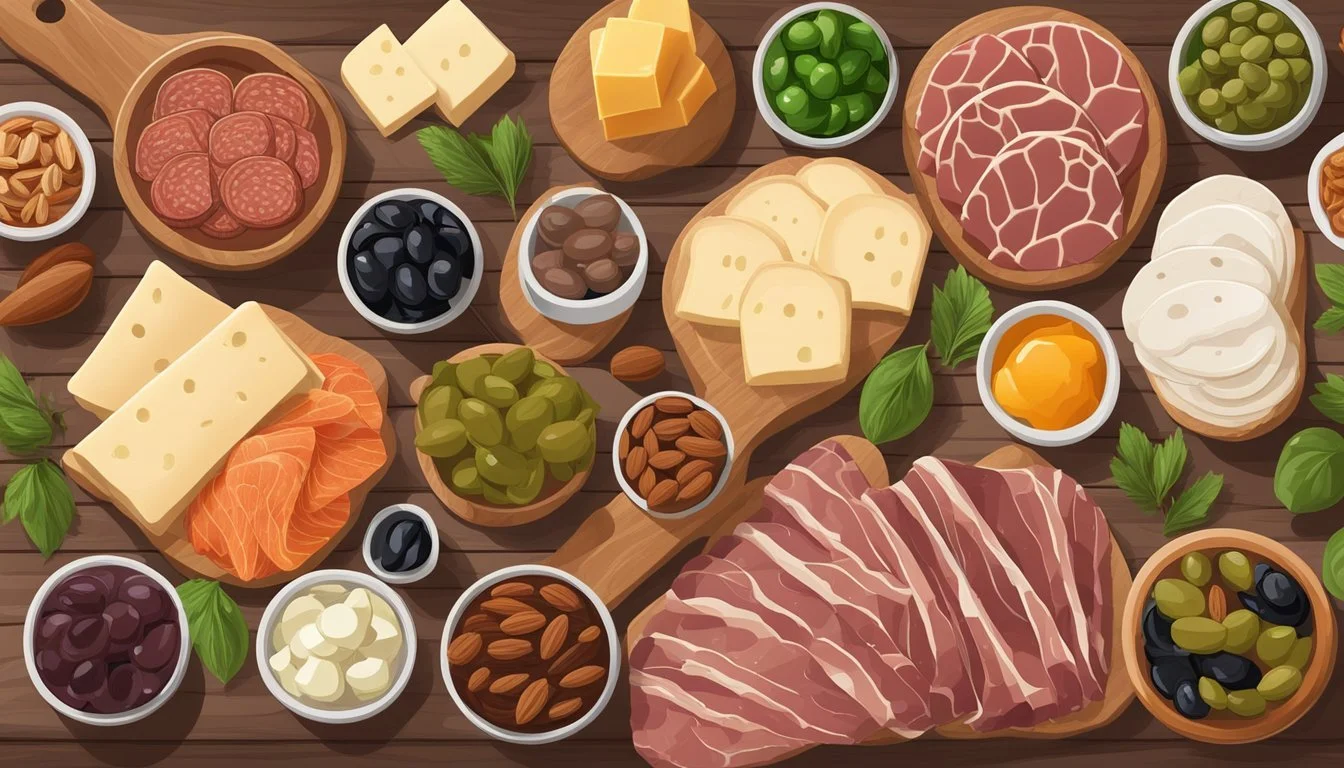Shelf-Stable Ingredient Pairings for Charcuterie Boards
Flavorful Combinations that Last
Charcuterie (What wine goes well with charcuterie?) boards have gained immense popularity as a versatile and sophisticated option for entertaining guests or enjoying a curated assortment of flavors. Central to the allure of charcuterie boards is the careful selection and pairing of ingredients that ensure a harmonious balance between taste and texture. Shelf-stable ingredients are particularly appealing as they offer both convenience and longevity, allowing for an easily assembled yet impressive display of savory meats, complementing cheeses, and varied accompaniments.
The creation of a charcuterie board is both an art and a science, with an emphasis on variety and quality. A well-constructed board often features a selection of cured meats, each bringing its unique flavor profile, from the sweetness of honeyed ham to the spice of chorizo. Cheeses are chosen for their textural contrast and flavor complementarity, ranging from the sharpness of aged cheddar to the creaminess of goat cheese. These primary components are then accented with a mix of nuts, dried fruits (What wine goes well with dried fruits?), olives, and artisanal bread or crisp crackers, all chosen to enhance the overall tasting experience.
Pairing these elements thoughtfully ensures that each bite offers a snapshot of the board's broader culinary landscape. Shelf-stable options not only simplify the assembly of charcuterie boards but also open up possibilities for unexpected pairings and taste combinations. The art lies in balancing flavors and textures while the science is knowing how each ingredient complements or contrasts with another. With careful selection, a charcuterie board can become a memorable centerpiece for any gathering.
Fundamentals of Charcuterie Board Pairings
A successful charcuterie board balances a variety of textures and flavors from cheeses, meats, and other shelf-stable ingredients to create an engaging and delicious experience.
Importance of Texture and Flavor Balance
When creating a charcuterie board, one must carefully consider the interplay between texture and flavor. An ideal board presents a contrast of smooth and rich items, like soft cheeses (What wine goes well with soft cheeses?), against more firm and bold counterparts, like hard cheeses. This balance not only delights the palate but also ensures each item can stand on its own while complementing the board as a collective.
Soft cheeses: Brie, camembert, which offer creamy textures
Hard cheeses: Aged cheddar, gouda, which provide a contrasting firmness
Cured meats: They contribute a savory flavor that balances the creaminess of soft cheeses.
Choosing the Right Cheeses
The selection of cheese plays a pivotal role in the harmony of a charcuterie board. For a well-rounded board, it's essential to incorporate a variety of cheeses:
Hard cheeses: Parmesan and manchego
Soft cheeses: Fresh mozzarella or burrata
Goat cheese: Offers a tangy flavor that contrasts with milder cheeses
Blue cheese: Adds a pungent edge to the arrangement
Each cheese is chosen for its unique flavor profile and texture, aiming to offer a palate that progresses from mild to bold.
Selecting Complementary Meats
Complementary meats should be carefully chosen based on their ability to enhance the cheeses. Cured meats such as salami, prosciutto, and ham are classic choices. They bring a range of textures from chewy to tender and a spectrum of flavors from sweet to spicy.
Salami: With its robust flavor and firm texture, it pairs well with hard cheeses.
Prosciutto: Its delicate, melt-in-your-mouth quality complements soft or creamy cheeses.
Ham: A versatile option, it works well with both bold and mild cheeses.
The pairing of these meats with cheeses should take into account the intensity of flavors to avoid overwhelming the palate.
Incorporating Shelf-Stable Vegetation
Shelf-stable vegetation such as pickles, olives, and dried fruits can add a delightful variety of sweet, sour, and acidic flavors to charcuterie boards. These items also introduce a spectrum of textures that complement the rich, savory notes of meats and cheeses.
Best Practices for Pickles and Olives
Shelf-stable pickles and olives bring a vital acidic component that cuts through the fattiness of charcuterie. They come in a variety of sizes, flavors, and textures. For pickles, one may consider options such as classic dill, bread and butter, or gherkins. Olives can range from the buttery and mild Castelvetrano to the firm and briny Kalamata.
Tips for Serving:
Offer a Variety: Include both green and black olives as well as pickles with different seasoning profiles.
Drain Well: To prevent the board from becoming soggy, ensure these items are well-drained before serving.
Container: Serve in small bowls or ramekins to contain their juices.
Utilizing Dried Fruits and Vegetables
Dried fruits and vegetables are versatile, shelf-stable choices that offer a natural sweetness or an intensified flavor of their fresh counterparts. Dried apricots, figs, and tomatoes can supplement the board's fruit component, while dried vegetable chips like beet or sweet potato provide a unique and satisfying crunch.
Suggestions for Integration:
Balance: Pair sweet dried fruits with strong-flavored cheeses or salty meats to balance flavors.
Hydration: If desired, certain dried fruits can be rehydrated in water or wine to restore a plumper texture.
Display: Scatter these items around the board for visual appeal and easy access.
By incorporating these shelf-stable options, hosts can ensure their charcuterie board remains a compelling array of tastes and textures that are both convenient and delicious.
Crunchy Additions
A well-crafted charcuterie board offers a variety of textures, and crunchy elements are essential. They not only provide a satisfying contrast to the softer cheeses and meats but can also offer additional fiber and protein to the selection.
Nuts and Seeds
Nuts such as almonds lend a rich, buttery crunch and are packed with protein, making them a fulfilling choice. They can be served raw or roasted to enhance their flavor. Besides almonds, consider adding walnuts for a slight bitterness or pecans for a sweeter touch.
Almonds: High in protein and versatile in flavor.
Walnuts: Offer a more complex, earthy note.
Pecans: Bring a sweeter, nutty quality.
Seeds serve as a crunchy alternative that is lower in calories but still rich in fiber. Pumpkin and sunflower seeds can be salted or seasoned with herbs for an extra kick.
Pumpkin Seeds: A fibrous choice with a subtle taste.
Sunflower Seeds: Smaller but bring a delightful pop of texture.
Crackers and Breads
Crackers must be selected with care to complement the other board components. They should be sturdy enough to hold toppings without overwhelming the flavors. Options range from simple water crackers to those infused with herbs or seeds.
Water Crackers: Mild in flavor, suitable for any topping.
Herb-infused Crackers: Add an aromatic dimension.
Seeded Crackers: Combine crunch with the nutritional benefits of various seeds.
Breads, when included, should be crispy and can act as a neutral canvas for stronger flavors. Thinly sliced baguettes, toasted until golden and crisp, or rustic artisanal breads can add depth to the board.
Baguette Slices: Offer a classic, crunchy base.
Artisanal Breads: Provide a hearty, satisfying crunch.
Sweet & Savory Condiments
Selecting the right condiments can elevate the flavors of a charcuterie board from good to great. Sweet condiments bring out the richness of cheeses and the savoriness of meats, while savory condiments add complexity and sharpness to the palate.
Jams, Honey, and Chocolates
Jams and Preserves: Offer a variety of jams, such as fig or berry, to provide a sweet counterbalance to salty meats and cheeses.
Fig Jam: Pairs well with Brie and goat cheese.
Berry Preserves: Complements the flavors of aged cheddar or Gouda.
Honey: Local honey not only supports regional businesses but also serves as a delightful drizzle over stronger cheeses like blue cheese or sharp cheddar.
Honeycomb: A piece of honeycomb on the board adds visual appeal and a textural contrast.
Chocolates: Small pieces of dark chocolate can be paired with alpine-style cheeses or enjoyed as a palate cleanser between different tastings.
Mustards and Chutneys
Mustards:
Honey Mustard: Brings a sweet and tangy flavor perfect for dipping pretzels or complementing smoked meats (What wine goes well with smoked meats?).
Whole Grain Mustard: Adds texture and a mild heat to sandwiches or as a condiment for artisan sausages.
Chutneys:
Mango Chutney: This sweet and tangy condiment pairs well with curried dishes, grilled meats, and robust cheeses.
Tomato Chutney: Offers a savory sweetness that complements everything from hard cheeses to cold cuts.
Cheese Board Construction Tips
Constructing a cheese board involves careful consideration of arrangement and the serving temperature, which both significantly enhance the experience.
Arrangement and Presentation
A cheese board's visual appeal is almost as important as the taste of its contents. Step-by-step construction begins with a solid foundation. One should select a variety of cheeses, cutting them into different shapes—wedges, blocks, rounds—adding visual and textural diversity. They must strategically place these cheeses across the board, considering the flow of how a guest might sample the flavors.
Colors and Textures: Integrate a mix of colors—orange from a Mimolette, blue from a Stilton, and the creamy white of a Brie.
Space and Flow: Ensure there is space between each cheese type to avoid flavor cross-contamination.
Labels: Providing labels next to each cheese variety guides guests and enhances the overall experience.
Italics on labels can highlight unique features or origins of the cheeses to captivate and inform guests.
Temperature and Serving Suggestions
The temperature at which cheese is served can dramatically affect its flavor and texture. Cheese should ideally be brought to room temperature before serving, as this enhances its natural flavors and softens firmer varieties. The ideal time to remove cheese from refrigeration is 30 minutes to an hour before serving.
Pre-Sliced Options: Offer a selection of pre-sliced cheeses for ease, but also include whole pieces with a knife for guests who prefer to cut their own portions.
Accompanying Tools: Provide appropriate utensils for each cheese, ensuring that guests have a seamless experience.
Presenting cheese at the right temperature and with the proper tools ensures each guest can fully enjoy the flavors and textures offered on the cheese board.
Special Ingredients for Distinctive Boards
Crafting a distinctive charcuterie board revolves around choosing shelf-stable ingredients that provide a fusion of flavors and textures. This section offers a deep dive into gourmet and international selections, and unique pairing ideas geared towards holiday celebrations.
Gourmet and International Selections
Elite charcuterie boards often feature gourmet cheeses such as Brie, Gouda, and Gruyère. These cheeses pair splendidly with a variety of cured meats. The robust flavor of aged Cheddar pairs particularly well with Italian salami, while the nuttiness of Gouda finds a friend in Spanish chorizo.
Experts might recommend incorporating international cheeses like Parmesan from Italy, known for its granular texture and salty, umami kick. It pairs well with prosciutto and honey-dipped almonds for a transcendent tasting experience.
Cheeses:
Brie: Soft and creamy, ideal with pears or fig spread.
Gouda: Aged varieties offer a caramel sweetness, excellent with apple slices.
Gruyère: Nutty and slightly sweet, perfect on rye bread with ham.
Parmesan: Granular texture, complements a thin slice of prosciutto.
Unique Pairing Ideas for Holidays
During the holidays, one might construct their board with special occasions in mind. Blue cheese, with its bold and tangy flavor profile, becomes a seasonal favorite. Try pairing it with a drizzle of honeycomb to balance its intensity—an eloquent addition to any festive spread.
For wine enthusiasts, a charcuterie board can be curated to complement specific wines served during the holidays. Red wine like Cabernet Sauvignon matches well with the bold flavors of blue cheese, while white wine enthusiasts might opt for a creamy brie or gouda to accompany their Chardonnay or Sauvignon Blanc. On the other hand, rosé pairs beautifully with softer cheeses and brings out the best in holiday fruit compotes.
Holiday Pairings:
Blue Cheese and Honeycomb with Cabernet Sauvignon
Creamy Brie with Chardonnay
Aged Gouda with Sauvignon Blanc
Fresh fruit compotes with rosé
By selecting special ingredients and considering unique combinations, one can elevate their charcuterie boards to be the centerpiece of any occasion, especially during the holidays.
Shelf-Stable Options for Every Occasion
Charcuterie boards are versatile and can be tailored to any event, utilizing shelf-stable items from the grocery store for convenience or focusing on long-term storage picks that ensure you're always ready to entertain.
Grocery Store Finds
When stocking up for charcuterie boards, shoppers can find an array of shelf-stable products at local grocery stores. It's key to select a variety of tastes and textures that require no refrigeration until opened.
Meats: Look for dry-cured sausages, pepperoni, and prosciutto, which are often vacuum-sealed.
Cheeses: Aged cheddars, goudas, and cheeses like Manchego can sit out for extended periods.
Crackers and Breads: Opt for sealed packages of artisanal crackers and breadsticks that remain fresh until needed.
Condiments and Spreads: Mustards, fruit preserves, and honey in jars are great for adding flavor without the need for fridge storage.
Nuts and Dried Fruits (What wine goes well with nuts and dried fruits?): Almonds, walnuts, and dried apricots or figs add crunch and sweetness.
Long-Term Storage Recommendations
For those who prioritize longevity and want their pantry ready for any occasion, consider these staples:
Meats: Smoked salmon packaged in airtight, sealed containers is an excellent choice for long-term storage; wrap carefully in plastic wrap after opening.
Cheeses: Hard cheeses encased in wax, like some forms of cheddar, can maintain quality for quite some time.
Crisps and Crackers: Baked goods sealed in tin containers can preserve freshness and are great for adding a crisp element to the board.
Seafood: Tinned seafood like oysters, mussels, (What wine goes well with mussels?) and anchovies (What wine goes well with anchovies?) bring a gourmet edge to any platter.
Olives and Pickles: They can often be found in jars or vacuum-sealed packs, adding a briny counterpoint to richer items on the board.
By selecting the right mix of grocery store finds and long-term storage items, one can assemble a tantalizing charcuterie board suitable for any gathering, from casual get-togethers to sophisticated parties.
Closing Thoughts
When curating a charcuterie board with shelf-stable ingredients, one must be adept in the art of balance and variety. The key is to select items that deliver a symphony of flavors and textures that cater to different palates. The board should include a range of meats, from the delicate sweetness of honey-glazed ham to the robust heat of spiced salami. One should also be mindful of portioning, aiming for about 2 to 3 ounces of meat per person.
In the realm of cheeses, an assortment of hard, aged options like Parmigiano-Reggiano to softer varieties like goat cheese offers both a diversity of tastes and a visual appeal. To accompany these, one can include assorted crackers and breadsticks that provide a satisfying crunch.
Condiments and pickles add an essential pop of color and acidity to offset the richness of the meats and cheeses. Items such as marinated olives, roasted red peppers, and artichoke hearts can be displayed in small bowls or scattered artfully around the board.
Lastly, nuts and dried fruits give a nod to the sweet component, providing a chewy contrast and rounding out the flavor profile.
To ensure guests have the optimal experience, always provide separate serving utensils for each element to maintain flavors.
Presentation matters greatly – take a moment to arrange each item with intention, allowing for easy access and an enticing display. A well-assembled charcuterie board with thoughtful, shelf-stable pairings not only satisfies the taste buds but also sparks conversation and brings people together.

